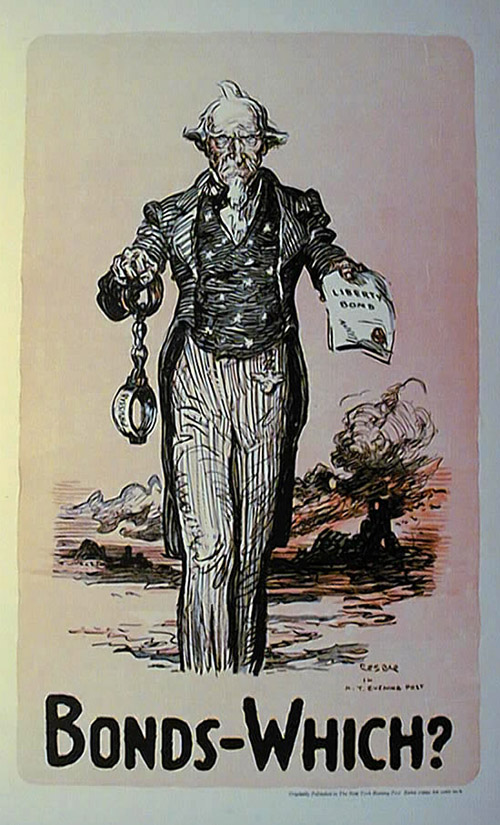
|
|
| As a symbol of patriotism, strength, and American ideals, Uncle Sam
is the United States government personified. His name originates
from the war of 1812 when boxes of food were shipped with the initials
U.S. Soldiers said that the food was sent from Uncle Sam. He
represents the armed forces in spirit for the entire nation.
Here, Uncle Sam is pictured in the forefront of the war. The colors used in the poster are dull in tone, which allows his figure to be easily recognized. In the distant background, fire and smoke appear to represent the battlefield. Thus, Uncle Sam appears to be emerging from the war with a message, emphasized by the figure's foreshortened finger. He is depicted with stern glare as if to express great concern about the war from which he is emerging. Uncle Sam's ultimatum refers to the financial support for the war through the purchasing of liberty bonds. He asks, "Bonds-Which?" He makes the statement that by not purchasing bonds, the public is jeopardizing America's freedom. The word "bond" has a dual meaning, first the liberty bond, and second as chained bonds. The chained bonds allude to the repercussions for not supporting the war effort. At this time, thousands of people had fled from the physical bonds of
their own countries for the freedom in the United States. For these
immigrants freedom meant the opportunity for a better life. Thus
this poster appeals to their new sense of American identity and desire
for freedom.
|
|
|
| Uncle Sam is calling on all Americans to purchase war bonds to secure
a future of freedom. Uncle Sam hands the liberty bond to the viewer,
demonstrating the ease with which Americans can obtain bonds. The
burnt-down, smoldering rubble behind him indicates the immediate need for
Americans’ help.
Furthermore, the handcuffs in his right hand also convey that haste must be taken in purchasing these bonds, otherwise Prussia will certainly become America’s new sovereign. With Prussia as her new governing body, Americans will lose their freedom and be subjected to harsh treatment. Uncle Sam’s stern face, combined with his direct eye contact with the viewer and his firm grip on the handcuffs, relays the message to buy war bonds immediately. Since Uncle Sam appears to be moving towards us, one can see how the picture might have been captured a few moments later. In this poster, his left hand is extended, giving us the liberty bonds, but in the next moment his right arm will be extended, handing us our own imprisonment. The emotions portrayed in this poster are exactly how then Secretary of the Treasury William Gibbs McAdoo intended to gain public support for war bonds. “McAdoo’s unwillingness to rely either on heavy taxation or on market-rate borrowing led directly to the effort to mobilize emotions instead, to substitute aroused patriotic fervor for the real economic price he would not ask the country to pay.” This poster demonstrates McAdoo’s attitude of increasing funds through other methods than that of raising taxes. His refusal to borrow or increase taxes promoted posters like this to inspire Americans. 1. David Kennedy, Over Here: The First World War and American
Society (Oxford: Oxford University Press, 1980).
|